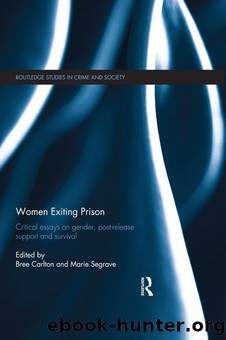Women Exiting Prison by Bree Carlton Marie Segrave

Author:Bree Carlton, Marie Segrave [Bree Carlton, Marie Segrave]
Language: eng
Format: epub
ISBN: 9780415831536
Barnesnoble:
Publisher: Taylor & Francis
Published: 2014-10-23T00:00:00+00:00
Prison and its aftermath
Over the past 15 years, Australian states and territories have âmanagedâ post-release needs largely via âthroughcareâ â a policy approach characterized by the âcontinuous, coordinated and integrated management of offendersâ from the offenderâs first point of contact with correctional services âto their successful reintegration into the community and completion of their legal orderâ (Clay 2002, 41). Throughcare aims to give offenders planned and case-managed opportunities for rehabilitation. Although the approach sounds reasonable in theory, there is little evidence that it is being implemented successfully, with disconnects between services and agencies at all points, lack of appropriate supports in the community and a punitive criminal justice culture that sees large numbers of people (especially those with mental and cognitive disability) being breached and returned to prison on technicalities. There are numerous problems with this approach (Baldry 2010), especially in relation to Indigenous women, as follows:
It is individualistic â while Indigenous women have agency, resilience and strengths, and are by no means mere âvictimsâ of systemic control or offending and violence against them in the community, throughcare arrangements, on the whole, âmanageâ and âcontrolâ persons who are being imprisoned and then released, fail them if they get âoff trackâ, and do not (in fact can not) address the structural factors that have criminalized and framed these womenâs lives.
It is founded on observations and studies of male prisoners and ex-prisoners in the United States and United Kingdom.
It ignores the fact that the majority of prisoners (the flow numbers rather than the static census numbers) are in prison for less than 12 months, and thus assumes that prisoners have adequate time in prison to develop case plans and attend programmes.
It assumes that supports in and after prison, and programmes and services for Indigenous women are appropriate and available; however, this is not generally the case (Baldry 2010; Bartels 2010).
It ignores the situation of remand prisoners, when in NSW, for example, a quarter of the prison population is on remand, with Indigenous women grossly overrepresented among remand prisoners.
It assumes an orderly process of arrest, court, sentencing, prison and release, which allows a plan to be made. This is so only in a small minority of cases, with the reality for most being that women are released directly from court after a period of remand, court dates are often changed, prisoners are moved from prison to prison, and prisonersâ families often face serious problems related to housing and other social matters due to the prisonerâs incarceration.
Download
This site does not store any files on its server. We only index and link to content provided by other sites. Please contact the content providers to delete copyright contents if any and email us, we'll remove relevant links or contents immediately.
Russia's Sakhalin Penal Colony, 1849â1917 by Andrew A. Gentes(176)
A History of Police and Masculinities, 1700-2010 by David G. Barrie Susan Broomhall(128)
Introduction to Criminal Justice - A Balanced Approach by Brian K. Payne Willard M. Oliver Nancy E. Marion(124)
Serial Killers America and UK - 2 BOOKS IN 1 by Clark Matthew(107)
Policing Gender, Class And Family In Britain, 1800-1945 by Linda Mahood(96)
Cops, Cameras, and Crisis by Michael D. White Aili Malm(90)
Restorative Justice in Transitional Settings by Kerry Clamp(88)
Dangerousness, Risk and the Governance of Serious Sexual and Violent Offenders by Karen Harrison(88)
Organized Crime and Corruption Across Borders by T. Wing Lo Dina Siegel Sharon I Kwok(85)
A Theory of African American Offending by James D. Unnever Shaun L. Gabbidon(82)
Losing Legitimacy by Gary Lafree(78)
The Real CSI by Kate Bendelow(76)
Routledge Handbook on Immigration and Crime by Holly Ventura Miller Anthony Peguero(73)
Forensic Criminology by Andy Williams(73)
The 1921 Tulsa Race Massacre by Chris M. Messer(73)
Broadmoor--My Journey Into Hell by Charlie Bronson(72)
Women Exiting Prison by Bree Carlton Marie Segrave(72)
Police Detectives in History, 1750â1950 by Clive Emsley Haia Shpayer-Makov(72)
Using Murder by Philip Jenkins(67)
